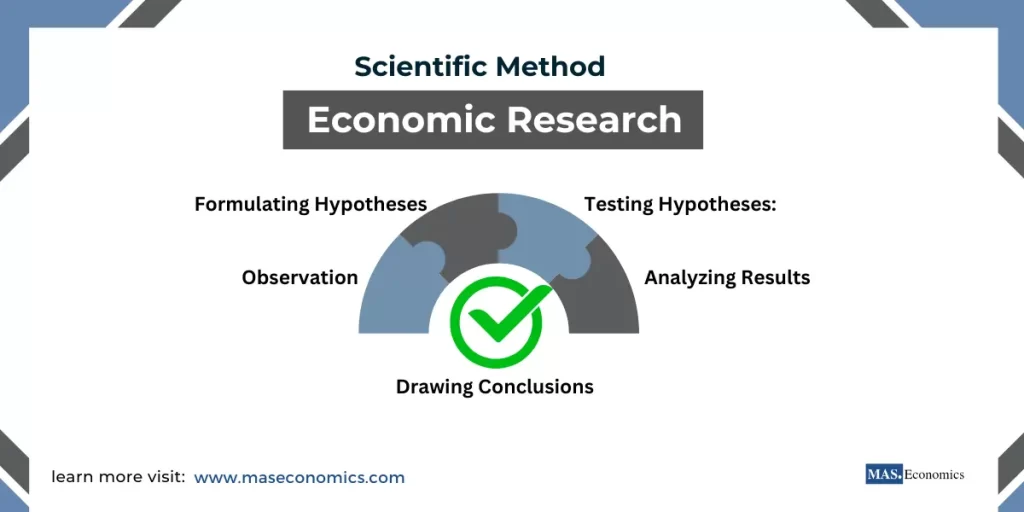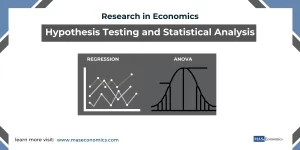The scientific method in economics is the cornerstone of rigorous economic research. By following a structured process of observation, hypothesis formulation, testing, analysis, and conclusion, economists can ensure that their research is systematic, objective, and verifiable. This method enables economists to explore complex economic phenomena, test economic theories, and provide insights that drive informed decision-making in both policy and business contexts.
In this article, we will dive deep into the scientific method, explaining its key steps, how it is applied in economics, and the importance of key characteristics like empiricism, verifiability, and ethical neutrality.
What Is the Scientific Method in Economics?
The scientific method is a systematic, logical approach to discovering how things work, aimed at producing reliable knowledge. In economics, it involves using empirical data to investigate and explain economic events and relationships, from consumer behavior to market dynamics. This method ensures that economic research is objective and based on real-world evidence rather than mere assumptions.
The scientific method in economics is essential for several reasons:
- It helps validate or refute economic theories.
- It provides policymakers with reliable insights to inform decisions.
- It ensures the research is transparent, reproducible, and grounded in data.
The steps of the scientific method are consistent across disciplines, but in economics, they are tailored to deal with real-world complexities and the behavior of markets, businesses, and individuals.
Key Steps of the Scientific Method in Economics
Observation
The first step in the scientific method is observation. Economists start by observing real-world economic phenomena to identify trends, anomalies, or areas of interest. These observations can come from a variety of sources: data on unemployment rates, shifts in consumer spending, changes in inflation, or fluctuations in stock prices.
For example, an economist might observe that during periods of economic recession, consumer spending decreases sharply. This observation raises questions about the underlying causes of this behavior, leading to further investigation.
Formulating a Hypothesis
Once an observation is made, the next step is to formulate a hypothesis. A hypothesis is a testable statement that predicts a relationship between two or more variables. In economics, hypotheses often explore cause-and-effect relationships. For example, based on the observation that consumer spending falls during recessions, an economist might hypothesize, “An increase in unemployment leads to a decrease in consumer spending.”
The hypothesis serves as the foundation for further research. It specifies what the economist expects to find and provides a clear direction for data collection and analysis.
Testing the Hypothesis
After formulating a hypothesis, the next step is to test it using empirical data. In economics, this often involves collecting data from a variety of sources, such as government reports, financial markets, or business surveys. Economists use statistical and econometric tools to analyze this data and determine whether the hypothesis holds true.
For example, to test the hypothesis that unemployment reduces consumer spending, an economist might gather data on unemployment rates and consumer spending levels over a set period. They would then use statistical models to analyze whether a correlation exists between the two variables.
The testing phase is critical because it allows economists to move from theoretical assumptions to evidence-based conclusions. This ensures that the findings are not just speculative but are grounded in observable data.
Analyzing the Results
Once the data is collected and analyzed, economists interpret the results to see if they support or contradict the hypothesis. This step involves assessing the strength and direction of relationships between variables. Economists may calculate p-values or confidence intervals to determine the statistical significance of their findings.
In our example, if the analysis shows a strong negative correlation between unemployment and consumer spending, the economist can conclude that the hypothesis is supported. Conversely, if no significant relationship is found, the hypothesis may need to be revised or rejected.
Drawing Conclusions
The final step is drawing conclusions based on the analysis. This step involves summarizing the research findings and discussing their implications for economic theory, policy, or business strategy. In many cases, the conclusions drawn from the research lead to new questions or hypotheses, continuing the cycle of scientific inquiry.
For instance, if the research supports the hypothesis that unemployment reduces consumer spending, policymakers might use this information to design interventions that stimulate demand during economic downturns.
Key Characteristics of the Scientific Method in Economics
To ensure that research is reliable and valuable, the scientific method in economics is underpinned by several key characteristics:
Empiricism
At the heart of the scientific method is empiricism, which means that research must be grounded in observable and measurable evidence. In economics, empiricism requires that theories and hypotheses be tested against real-world data, whether through consumer surveys, financial market data, or national economic indicators.
For example, to study inflation, economists gather data on price levels, wages, and monetary policies. Empirical evidence ensures that economic theories are not based on abstract assumptions but on actual observations of how economies function.
Verifiability
Verifiability means that other researchers should be able to replicate the findings of a study by following the same methods and using the same data. This is essential for ensuring that research conclusions are robust and reliable. If a study on the impact of interest rates on investment yields consistent results across multiple analyses, it reinforces the credibility of the findings.
Verifiability also enhances transparency in economics, allowing others to critically assess the methodology and conclusions of a study.
Cumulative Knowledge
Economic research builds on the work of previous researchers, making it cumulative in nature. Each new study contributes to the broader body of knowledge, refining, supporting, or challenging established theories.
For example, the Phillips Curve, which posits an inverse relationship between inflation and unemployment, has been tested and refined by countless studies over decades. As new data emerges, economists can update the theory to reflect modern economic realities. This cumulative process helps economics evolve and stay relevant in an ever-changing world.
Ethical and Ideological Neutrality
Ethical neutrality is essential in the scientific method. Economists must remain objective, basing their research on data and analysis rather than personal beliefs or ideological preferences. This ensures that the research remains credible and unbiased, making it more useful for policymakers and businesses.
For example, when studying the impact of tax cuts on income distribution, economists should avoid letting personal views on taxation influence their analysis. Ethical neutrality requires that they present findings honestly, even if the results contradict their expectations.
Statistical Generalization
Finally, statistical generalization plays a key role in economic research. By analyzing a sample of data, economists can make inferences about a larger population. This is particularly important in economics, where studying every individual or firm is often impossible. For instance, an economist studying consumer spending might analyze a sample of households to make general conclusions about national spending patterns.
This process allows researchers to draw conclusions that are relevant to broader economic trends, making the research more impactful and applicable to real-world scenarios.
Conclusion
The scientific method in economics provides a structured and reliable framework for investigating economic phenomena. By following the steps of observation, hypothesis formulation, testing, analysis, and conclusion, economists can ensure that their research is objective, verifiable, and grounded in empirical evidence.
The key characteristics of the scientific method — empiricism, verifiability, cumulative knowledge, and ethical neutrality — ensure that economic research contributes meaningfully to our understanding of how economies work. Whether it’s guiding government policies or helping businesses make data-driven decisions, the scientific method remains at the core of economic inquiry, driving progress and innovation in the field.
As we continue through this series, we will explore how these principles apply to different types of research, from descriptive to explanatory, and how economists use them to answer pressing questions in today’s complex economic landscape.
FAQs
What is the scientific method in economics?
The scientific method in economics is a systematic approach used by economists to investigate economic phenomena. It involves observing real-world events, forming hypotheses, testing them with empirical data, analyzing the results, and drawing conclusions to ensure that research is objective and verifiable.
Why is the scientific method important in economics?
The scientific method is important in economics because it provides a structured and reliable framework for understanding economic events. It allows economists to validate or refute theories, offer evidence-based policy recommendations, and ensure that research is grounded in observable data.
What are the key steps in the scientific method in economics?
The key steps in the scientific method in economics include observation, hypothesis formulation, testing the hypothesis with data, analyzing the results, and drawing conclusions. These steps help ensure that economic research is systematic, transparent, and based on empirical evidence.
How is a hypothesis formulated in economics?
In economics, a hypothesis is formulated as a testable prediction about the relationship between two or more variables. For example, an economist might hypothesize that “higher interest rates reduce consumer spending.” This hypothesis will then guide the data collection and analysis process.
How do economists test hypotheses?
Economists test hypotheses by collecting and analyzing empirical data using statistical and econometric tools. For example, to test the hypothesis that unemployment affects consumer spending, an economist might analyze data on unemployment rates and consumer spending levels to assess if a correlation exists.
What is the role of empirical data in the scientific method?
Empirical data is central to the scientific method as it provides real-world evidence to test hypotheses and theories. In economics, this might involve analyzing national economic indicators, consumer surveys, or financial market data to draw conclusions about economic behaviors and trends.
How does verifiability ensure reliability in economic research?
Verifiability ensures that other researchers can replicate the findings of a study by using the same methods and data. This reinforces the credibility of the research and ensures that its conclusions are robust and applicable in different contexts.
What is ethical neutrality in the scientific method?
Ethical neutrality in the scientific method means that economists must conduct their research objectively, without allowing personal beliefs or ideologies to influence their analysis. This ensures that the results are unbiased and reliable for policymakers and businesses.
How do economists use statistical generalization?
Statistical generalization allows economists to analyze a sample of data and make inferences about a larger population. For example, by studying a sample of households, an economist can draw conclusions about national consumer spending patterns, ensuring the research is relevant to broader economic trends.
Thanks for reading! Share this with friends and spread the knowledge if you found it helpful.
Happy learning with MASEconomics




